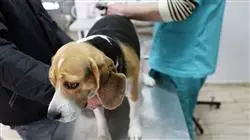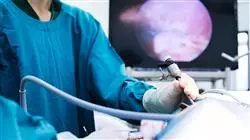University certificate
The world's largest faculty of veterinary medicine”
Introduction to the Program
Veterinarians must continue their education to adapt to new developments in this field”

Minimally Invasive Techniques for the Diagnosis and Treatment of various diseases in small animals were first implemented in veterinary medicine 20 years ago and have had exponential growth in the last decade.
This upturn, which goes hand in hand with the progress made by human medicine in the field, is owed to several factors: technical development, equipment and instruments that offer higher quality images and are more affordable; the development of specific diagnostic and therapeutic techniques, as well as of professionals who are better trained and carry out most of their clinical activities through these minimally invasive techniques, in addition to owners who are ever more concerned about the health of their pets and demand more specialized clinical services, more accurate clinical diagnoses and treatments that are less invasive and that will result in lower pain levels and fewer hospitalizations for their pets.
The teaching staff of this Postgraduate Diploma are at the forefront of the latest diagnostic techniques and treatment of diseases in small animals. Thanks to their specialized training, they have developed a useful and practical program that is adapted to the current reality, a reality that is becoming more and more demanding and specialized.
The teaching team has selected an agenda that generates specialized knowledge with an overview of the importance of minimally invasive techniques for the diagnosis and treatment of many diseases affecting small animals, in the description of equipment, instruments, approaches in minimally invasive surgery, anesthesia and most frequent complications.
It provides high-quality multimedia material on different surgical techniques, from the simplest and most common to the most technically complex.
As it is an online Postgraduate Diploma course, students are not restricted by set timetables, nor do they need to physically move to other locations. All of the content can be accessed at any time of the day, so you can balance your working or personal life with your academic life.
This training is the best option you can find to specialize in Diagnostic and Treatment Procedures for Minimally Invasive Surgery in Small Animals and make more accurate diagnoses”
This Postgraduate diploma in Diagnosis and Minimally Invasive Surgical Treatment in Small Animals contains the most complete and up-to-date educational program on the market. The most important features of the program include:
- Case studies presented by experts in Minimally Invasive Veterinary Surgery in Small Animals
- The graphic, schematic, and practical contents with which they are created provide scientific and practical information on the disciplines, essential for professional development.
- Latest developments in Minimally Invasive Veterinary Surgery in Small Animals
- Practical exercises where self-assessment can be used to improve learning.
- Special emphasis on innovative methodologies in Minimally Invasive Veterinary Surgery in Small Animals
- Theoretical lessons, questions to the expert, debate forums on controversial topics, and individual reflection assignments
- Content that is accessible from any fixed or portable device with an Internet connection
This Postgraduate diploma 100% online and will enable you to combine your studies while increasing your knowledge in this field”
The teaching staff includes professionals from the field of Minimally Invasive Veterinary Surgery who bring their experience to this training program, as well as renowned specialists from leading societies and prestigious universities.
The multimedia content, developed with the latest educational technology, will provide the professional with situated and contextual learning, i.e., a simulated environment that will provide immersive learning programmed to train in real situations.
This program is designed around Problem-Based Learning, whereby the professional must try to solve the different professional practice situations that arise throughout the program. For this purpose, the professional will be assisted by an innovative system of interactive videos created by experienced and renowned experts from within Veterinary Surgery.
Don’t miss the opportunity to study this Postgraduate diploma in Diagnosis and Minimally Invasive Surgical Treatment in Small Animals with us” It's the perfect opportunity to advance your career.

This program comes with the best educational material, providing you with a contextual approach that will facilitate your learning.
Why study at TECH?
TECH is the world’s largest online university. With an impressive catalog of more than 14,000 university programs available in 11 languages, it is positioned as a leader in employability, with a 99% job placement rate. In addition, it relies on an enormous faculty of more than 6,000 professors of the highest international renown.

Study at the world's largest online university and guarantee your professional success. The future starts at TECH”
The world’s best online university according to FORBES
The prestigious Forbes magazine, specialized in business and finance, has highlighted TECH as “the world's best online university” This is what they have recently stated in an article in their digital edition in which they echo the success story of this institution, “thanks to the academic offer it provides, the selection of its teaching staff, and an innovative learning method aimed at educating the professionals of the future”
A revolutionary study method, a cutting-edge faculty and a practical focus: the key to TECH's success.
The most complete study plans on the university scene
TECH offers the most complete study plans on the university scene, with syllabuses that cover fundamental concepts and, at the same time, the main scientific advances in their specific scientific areas. In addition, these programs are continuously being updated to guarantee students the academic vanguard and the most in-demand professional skills. In this way, the university's qualifications provide its graduates with a significant advantage to propel their careers to success.
TECH offers the most comprehensive and intensive study plans on the current university scene.
A world-class teaching staff
TECH's teaching staff is made up of more than 6,000 professors with the highest international recognition. Professors, researchers and top executives of multinational companies, including Isaiah Covington, performance coach of the Boston Celtics; Magda Romanska, principal investigator at Harvard MetaLAB; Ignacio Wistumba, chairman of the department of translational molecular pathology at MD Anderson Cancer Center; and D.W. Pine, creative director of TIME magazine, among others.
Internationally renowned experts, specialized in different branches of Health, Technology, Communication and Business, form part of the TECH faculty.
A unique learning method
TECH is the first university to use Relearning in all its programs. It is the best online learning methodology, accredited with international teaching quality certifications, provided by prestigious educational agencies. In addition, this disruptive educational model is complemented with the “Case Method”, thereby setting up a unique online teaching strategy. Innovative teaching resources are also implemented, including detailed videos, infographics and interactive summaries.
TECH combines Relearning and the Case Method in all its university programs to guarantee excellent theoretical and practical learning, studying whenever and wherever you want.
The world's largest online university
TECH is the world’s largest online university. We are the largest educational institution, with the best and widest online educational catalog, one hundred percent online and covering the vast majority of areas of knowledge. We offer a large selection of our own degrees and accredited online undergraduate and postgraduate degrees. In total, more than 14,000 university degrees, in eleven different languages, make us the largest educational largest in the world.
TECH has the world's most extensive catalog of academic and official programs, available in more than 11 languages.
Google Premier Partner
The American technology giant has awarded TECH the Google Google Premier Partner badge. This award, which is only available to 3% of the world's companies, highlights the efficient, flexible and tailored experience that this university provides to students. The recognition as a Google Premier Partner not only accredits the maximum rigor, performance and investment in TECH's digital infrastructures, but also places this university as one of the world's leading technology companies.
Google has positioned TECH in the top 3% of the world's most important technology companies by awarding it its Google Premier Partner badge.
The official online university of the NBA
TECH is the official online university of the NBA. Thanks to our agreement with the biggest league in basketball, we offer our students exclusive university programs, as well as a wide variety of educational resources focused on the business of the league and other areas of the sports industry. Each program is made up of a uniquely designed syllabus and features exceptional guest hosts: professionals with a distinguished sports background who will offer their expertise on the most relevant topics.
TECH has been selected by the NBA, the world's top basketball league, as its official online university.
The top-rated university by its students
Students have positioned TECH as the world's top-rated university on the main review websites, with a highest rating of 4.9 out of 5, obtained from more than 1,000 reviews. These results consolidate TECH as the benchmark university institution at an international level, reflecting the excellence and positive impact of its educational model.” reflecting the excellence and positive impact of its educational model.”
TECH is the world’s top-rated university by its students.
Leaders in employability
TECH has managed to become the leading university in employability. 99% of its students obtain jobs in the academic field they have studied, within one year of completing any of the university's programs. A similar number achieve immediate career enhancement. All this thanks to a study methodology that bases its effectiveness on the acquisition of practical skills, which are absolutely necessary for professional development.
99% of TECH graduates find a job within a year of completing their studies.
Postgraduate Diploma in Diagnosis and Minimally Invasive Surgical Treatment in Small Animals
.
Are you ready to become a Postgraduate Diploma in Diagnosis and Minimally Invasive Surgical Treatment in Small Animals? Get ready to get a jump start on your veterinary career with TECH Global University's Veterinary School's online program! Imagine the excitement of acquiring specialized skills in minimally invasive surgery, an ever-growing field that has revolutionized small animal treatment. With our program, you will immerse yourself in the fascinating world of advanced surgical techniques, such as endoscopy, laparoscopy, arthroscopy and thoracoscopy. One of the most outstanding advantages of this program is that it is taught online, which allows you to study from anywhere in the world without sacrificing the quality of education. Would you like to learn from the comfort of your home, adapting your schedule to your pace of life? This is your chance! Our teaching team is composed of highly qualified professionals with extensive experience in minimally invasive small animal surgery. They will guide you throughout the program, sharing their knowledge and providing you with a comprehensive specialization so that you become an expert.
The future of small animal surgery is in your hands.
The future awaits you and at TECH we are here to help you achieve it!
.
Upon successful completion of the program, you will receive an internationally recognized certificate that endorses your skills and knowledge in the field of surgery. This certificate will open doors to incredible career opportunities in both renowned veterinary clinics and specialized hospitals around the world. During the program, you will explore a wide range of topics, from the fundamentals of minimally invasive surgery to advanced techniques and real clinical cases. You'll learn how to perform surgical procedures with precision, minimizing pain and speeding recovery for your furry patients. You will be able to apply these innovative techniques in various areas, such as abdominal surgery, orthopedics, urology and much more. Being part of our community will provide you with an invaluable network of contacts and open doors to a promising future in the field of veterinary medicine.







